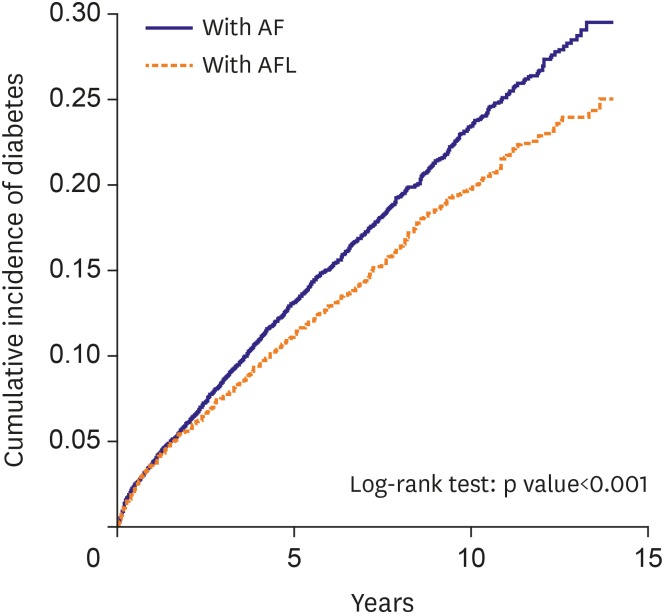Korean Circ J.
2020 Jun;50(6):527-532. 10.4070/kcj.2019.0367.
Comparison of New-Onset Diabetes Mellitus among Patients with Atrial Fibrillation or Atrial Flutter
- Affiliations
-
- 1School of Medicine, College of Medicine, China Medical University, Taichung, Taiwan
- 2Division of Cardiovascular Medicine, Department of Medicine, China Medical University Hospital, Taichung, Taiwan
- 3Management Office for Health Data, China Medical University Hospital, Taichung, Taiwan
- KMID: 2500955
- DOI: http://doi.org/10.4070/kcj.2019.0367
Abstract
- Background and Objectives
The objective was to compare the rate of onset of diabetes mellitus (DM) in patients with atrial fibrillation (AF) as compared with atrial flutter (AFL).
Methods
The incidence of DM through the national cohort registry in 14,014 newly diagnosed AF and 14,014 newly diagnosed AFL was investigated. Propensity score matching was used to optimize comparability between these 2 groups. Further analysis with Cox model, Kaplan-Meier methods and competing risk analysis were used to compare the incidence of DM in patients with AF and AFL.
Results
The overall incidence of diabetes was higher among cases in AF cohort (1,653 diabetes cases, 11.7%) than in AFL cohort (1,448 diabetes cases, 10.3%). The risk of diabetes was 1.17-fold greater in the AF cohort compared with that in the AFL cohort (95% confidence interval [CI], 1.09–1.25; p<0.001). After adjustment for all relevant confounding factors in the competing risk regression model, the risk of diabetes remained significantly increased 1.16-fold in the AF cohort (95% CI, 1.09–1.25; p<0.001).
Conclusions
The message of higher incidence rate of DM in patients with AF compared to those with AFL was delivered in this study.
Figure
Reference
-
1. Emerging Risk Factors Collaboration. Sarwar N, Gao P, et al. Diabetes mellitus, fasting blood glucose concentration, and risk of vascular disease: a collaborative meta-analysis of 102 prospective studies. Lancet. 2010; 375:2215–2222. PMID: 20609967.2. 2014 United States Renal Data System Annual Data Report: Epidemiology of kidney disease in the United States. Bethesda (MD): National Institutes of Health, National Institute of Diabetes and Digestive and Kidney Diseases;2014. p. 188–210.3. Staerk L, Sherer JA, Ko D, Benjamin EJ, Helm RH. Atrial fibrillation: epidemiology, pathophysiology, and clinical outcomes. Circ Res. 2017; 120:1501–1517. PMID: 28450367.4. Chugh SS, Havmoeller R, Narayanan K, et al. Worldwide epidemiology of atrial fibrillation: a Global Burden of Disease 2010 Study. Circulation. 2014; 129:837–847. PMID: 24345399.5. Paneni F, Beckman JA, Creager MA, Cosentino F. Diabetes and vascular disease: pathophysiology, clinical consequences, and medical therapy: part I. Eur Heart J. 2013; 34:2436–2443. PMID: 23641007.
Article6. Lüscher TF, Creager MA, Beckman JA, Cosentino F. Diabetes and vascular disease: pathophysiology, clinical consequences, and medical therapy: part II. Circulation. 2003; 108:1655–1661. PMID: 14517152.7. Sowers JR. Diabetes mellitus and vascular disease. Hypertension. 2013; 61:943–947. PMID: 23595139.
Article8. Odutayo A, Wong CX, Hsiao AJ, Hopewell S, Altman DG, Emdin CA. Atrial fibrillation and risks of cardiovascular disease, renal disease, and death: systematic review and meta-analysis. BMJ. 2016; 354:i4482. PMID: 27599725.
Article9. Conen D, Chae CU, Glynn RJ, et al. Risk of death and cardiovascular events in initially healthy women with new-onset atrial fibrillation. JAMA. 2011; 305:2080–2087. PMID: 21610240.
Article10. Emdin CA, Wong CX, Hsiao AJ, et al. Atrial fibrillation as risk factor for cardiovascular disease and death in women compared with men: systematic review and meta-analysis of cohort studies. BMJ. 2016; 532:h7013. PMID: 26786546.
Article11. Bohne LJ, Johnson D, Rose RA, Wilton SB, Gillis AM. The association between diabetes mellitus and atrial fibrillation: clinical and mechanistic insights. Front Physiol. 2019; 10:135. PMID: 30863315.
Article12. De Sensi F, De Potter T, Cresti A, Severi S, Breithardt G. Atrial fibrillation in patients with diabetes: molecular mechanisms and therapeutic perspectives. Cardiovasc Diagn Ther. 2015; 5:364–373. PMID: 26543823.13. Goudis CA, Korantzopoulos P, Ntalas IV, Kallergis EM, Liu T, Ketikoglou DG. Diabetes mellitus and atrial fibrillation: pathophysiological mechanisms and potential upstream therapies. Int J Cardiol. 2015; 184:617–622. PMID: 25770841.
Article14. Şerban RC, Scridon A. Data linking diabetes mellitus and atrial fibrillation-how strong is the evidence? From epidemiology and pathophysiology to therapeutic implications. Can J Cardiol. 2018; 34:1492–1502. PMID: 30404752.
Article15. Mareedu RK, Abdalrahman IB, Dharmashankar KC, et al. Atrial flutter versus atrial fibrillation in a general population: differences in comorbidities associated with their respective onset. Clin Med Res. 2010; 8:1–6. PMID: 19920163.
Article16. Fuster V, Rydén LE, Cannom DS, et al. ACC/AHA/ESC 2006 guidelines for the management of patients with atrial fibrillation: a report of the American College of Cardiology/American Heart Association Task Force on Practice Guidelines and the European Society of Cardiology Committee for Practice Guidelines (Writing Committee to Revise the 2001 Guidelines for the Management of Patients With Atrial Fibrillation): developed in collaboration with the European Heart Rhythm Association and the Heart Rhythm Society. Circulation. 2006; 114:e257–354. PMID: 16908781.17. National Health Research Institutes (TW). National Health Insurance Research Database [Internet]. Zhunan: National Health Research Institutes;c2020. cited 2015 Apr 14. Available from http://nhird.nhri.org.tw/en/index.html.18. Hu WS, Lin CL. Suicide attempt in patients with atrial fibrillation - A nationwide cohort study. Prog Neuropsychopharmacol Biol Psychiatry. 2019; 92:470–475. PMID: 30707991.
Article19. Hu WS, Lin CL. CHA2DS2-VASc score in the prediction of ischemic bowel disease among patients with atrial fibrillation: Insights from a nationwide cohort. Int J Cardiol. 2017; 235:56–60. PMID: 28262350.
- Full Text Links
- Actions
-
Cited
- CITED
-
- Close
- Share
- Similar articles
-
- Management of Atrial Flutter
- Electrophysiologic Characteristics in the Process of Conversion from Atrial Fibrillation to Atrial Flutter
- A case of fetal atrial flutter with hydrops fetalis
- Development of atrial flutter after induction of general anesthesia and conversion to atrial fibrillation: A case report
- Transesophageal Atrial Pacing in Atrial Flutter


